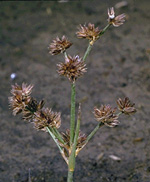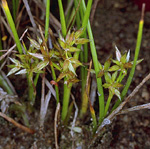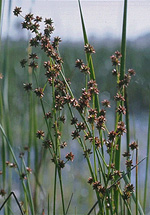 |
This large family is almost cosmopolitan, mostly in temperate and cold climates. In Australia various species, especially of the large genus Juncus, may be found in open habitats almost anywhere, especially if there is sufficient water to form perennial or semi-permanent wetlands or shallow swamps; relatively few species occur in the tropics, and the greatest diversity is in the montane south-eastern mainland and in Tasmania.
Characteristic features of the family Juncaceae in Australia include: - annual or perennial rush-like or grass-like plants, tufted or with creeping, short rhizomes
- leaves usually basal, flat to cylindrical or (in many species of Juncus)
reduced to papery sheaths and the cylindrical flowering stems providing
the photosynthetic structures
- flowers small, with 6 greenish to dark brown, narrowly triangular, scale-like perianth parts
- ovary superior with helically coiled style, developing into a capsular fruit
Description
Annual or perennial terrestrial herbs, or aquatic herbs rooted in the substrate with their leaves emergent. Perennating by rhizomes. Vegetative reproduction absent or by rhizomes. Leaves sometimes ±absent and their function performed by sterile stems/inflorescence stalks. Stem internodes spongy or pithy or hollow, terete or oval or slightly flattened. Internal secretions not obvious. Plants glabrous, or with simple, non-glandular, multiseriate hairs. Leaves well developed or much reduced (i.e. to scales, etc), alternate and spiral, cauline, all or mostly basal, or both basal and cauline, sessile. Stipule-like lobes absent. Lamina simple, symmetric, filiform, acicular, subulate, linear or oblong; base attenuate or lobed, rarely auriculate; margins entire, ±flat; venation parallel, with the midrib conspicuous or inconspicuous, and the tertiary venation not reticulate; surfaces not punctate; herbaceous, leathery or rarely hard and spinose. Leaf ligule absent. Usually with all the flowers bisexual, or rarely with male and female flowers occurring on separate plants. Inflorescences terminal, usually of dichasial or monochasial cymes, or rarely of solitary flowers. Bracts present. Bracteoles present or absent. Pollination by wind. Flowers odourless; stalked. Floral disc absent; nectaries absent. Perianth regular, of 1 whorl only or all whorls ±similar, with 6 free ±petaloid segments, white, cream, green, grey, brown or black, without contrasting markings, or rarely with contrasting markings (e.g. streaks, spots, etc); inner perianth parts herbaceous. Fertile stamens 3 or 6, opposite to and free of the perianth segments, free of the ovary and style, distinct from each other, all ±equal. Anthers basifixed, not versatile, opening sideways or inwards by longitudinal slits, 2-celled. Ovary superior and sessile. Carpels 3, fused; ovary with 1–3 locules. Style terminal, single and branched above. Ovules 3–numerous per locule, stalked; placentation basal, parietal or free-central. Fruit a dry, dehiscent loculicidal capsule; the perianth on the maturing fruit dry and persistent. Disseminule micro-surface ±reticulate, cream, red, brown or black, dull. Seeds 4–numerous per fruit. Aril present or absent. Cotyledons 1. Embryo straight.
(Note: this description has been generated from the coded data compiled for the key. Any errors in the key data will be reflected in the descriptions.)
A treatment of the family Juncaceae has not yet been published in the Flora of Australia. It will appear in Volume 40.
Australian genera of Juncaceae (as recognised for the Flora of Australia)
† = some species native, others introduced
†Juncus
Luzula

|
  |

Juncus articulatus (flowers)
Photo: C.Totterdell © ANBG

Juncus falcatus (flowers)
Photo: C.Totterdell © ANBG

Juncus fockei (flowering plant)
Photo: M.Fagg © ANBG

Juncus prismatocarpus (fruits)
Photo: M.Fagg © ANBG

|
 |
|